Austal USA Launches Large USV Vanguard for US Navy
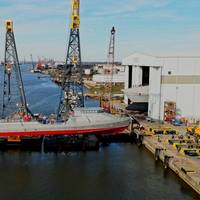
The U.S. Navy’s newest Overlord Unmanned Surface Vessel Vanguard (OUSV3), was recently launched from Austal USA’s shipyard in Mobile, Ala. Vanguard is the first USV for the Navy purpose-built for autonomous operations from the keel-up.Vanguard is being jointly developed by a team led by Austal USA and L3Harris. Once outfitting and testing is completed, Vanguard will autonomously transit to San Diego, joining sister ships, OUSV2 Ranger and OUSV4 Mariner, as part of the Navy’s USV Division 1.
Unmanned Maritime Systems Development Accelerates
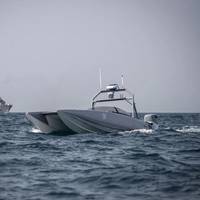
There is little question that world militaries see the value of unmanned systems to complement their manned counterparts. The wars in Iraq and Afghanistan accelerated the development of unmanned aerial systems and unmanned ground systems to meet urgent operational needs. Now, there is increasing interest in unmanned surface systems, resulting in their placement on an accelerated development path.Like their air and ground counterparts, these unmanned surface systems are valued because of their ability to reduce the risk to human life in high threat areas…
U.S. Navy: Unmanned Maritime Systems Development Accelerates
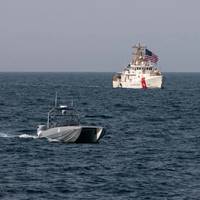
There is little question that world militaries see the value of unmanned systems to complement their manned counterparts. The wars in Iraq and Afghanistan accelerated the development of unmanned aerial systems and unmanned ground systems to meet urgent operational needs. Now, there is increasing interest in unmanned surface systems, resulting in their placement on an accelerated development path.Like their air and ground counterparts, these unmanned surface systems are valued because of their ability to reduce the risk to human life in high threat areas…
Subsea Defense: Navy Deepens Commitment to Underwater Vehicles
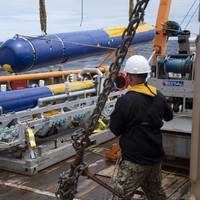
The U.S. Navy uses unmanned and robotic underwater vehicles for a multitude of functions, including environmental sensing, mine hunting, and salvage. The Navy plans to evolve an unmanned systems operating concept that is platform agnostic and capable of operating in highly complex contested environments with minimal operator interaction.The most recent edition of the Navy’s Unmanned Systems (UxS) Roadmap was issued in 2018, and a new version is expected in the near future. The 2018 document states that UxS will operate in every domain…
Metal Shark Developing Autonomous Vessel for US Marine Corps
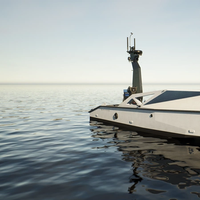
Autonomous vessels are quickly gaining acceptance across the maritime sector, but especially in government and military applications where the technological and safety advantages are most pronounced.On Monday, Louisiana-based shipbuilder Metal Shark said it has been selected by the U.S. Marine Corps to develop and implement the Long Range Unmanned Surface Vessel (LRUSV) System, a network of unmanned vessels traveling autonomously for extended ranges and transporting loitering munitions to address targets at sea and on land.The weapons system will be tiered and scalable…
U.S. Navy, NOAA Strike Deal to Fast-Track Unmanned Maritime Systems
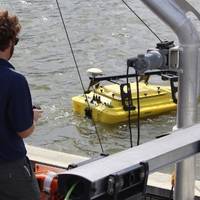
The advent of autonomy in the maritime and subsea space has received a significant boost with the announcement that a pair of U.S. government titans, the United States Navy and NOAA, have inked an deal to jointly expand the development and operations of unmanned maritime systems.“With the strengthening of our ongoing partnership with the Navy, NOAA will be better positioned to transition unmanned maritime technologies into operational platforms that will gather critical environmental data that will help grow the American Blue Economy,” said retired Navy Rear Adm.
Sea Machines Raises $15 Mln, Partners with Huntington Ingalls Industries
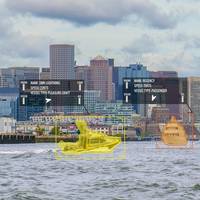
Autonomous vessel technology developer Sea Machines Robotics announced Wednesday it has closed a new $15 million financing round with significant participation by America's largest military shipbuilder Huntington Ingalls Industries (HII).The Boston-based tech company said it expects the investment and associated partnership with HII will accelerate the deployment of self-piloting technologies for unmanned naval boats and ships as the defense shipbuilding and technology giant continues…
US Navy Awards Unmanned Surface Vehicle Prototype Contract

The U.S. Navy on Monday awarded a $34,999,948 to L3 Technologies, Inc. for the development of a single medium unmanned surface vehicle (MUSV) prototype, with options to procure up to eight additional MUSVs. The award follows a full and open competitive procurement process.Funding is in place on this contract for the initial prototype. With all options exercised, the contract is valued at $294,508,976 if additional funding is provided in future budget years.“The award of Medium USV is the culmination of a great dialogue with industry to right-size the requirements for a capable…
Interview: Dr. Catherine Warner, Director, NATO CMRE

At CMRE, it’s not just about the science. It’s about building trust and confidence in resilient systems. An interview with Dr. Catherine Warner, Director, NATO Center for Maritime Research and Experimentation, La Spezia, ItalyTell us a little about yourself and CMRE. What does CMRE do, and how do you see your mission evolving?I came here from the Pentagon, where I was the science advisor for the director of operational test and evaluation. My experience has been working with operators on systems that they’re getting ready to field.
Royal Navy taps Autonomous Vehicles
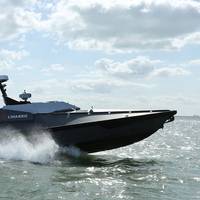
L3Harris Technologies delivered a new class of Autonomous Surface Vehicle (ASV) with advanced capabilities to serve the United Kingdom’s Royal Navy.The Maritime Autonomy Surface Testbed (MAST) 13 is a 13-meter (41-ft.) long high-speed system capable of fully autonomous navigation. The ASV uses L3Harris’ ASView proprietary autonomous control system and advanced algorithms developed for the U.K.’s Defense Science and Technology Laboratory (Dstl).Designed, built and commissioned by L3Harris’ Unmanned Maritime Systems team based on the south coast of the UK…
Ship Tech: U.S. Coast Guard R&D Center
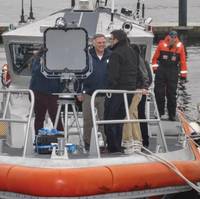
The U.S. Coast Guard Research and Development Center (RDC) in New London, Connecticut, is the service's only command conducting research, development, test and evaluation (RDT&E) support for all 11 statutory missions. Since its commissioning in 1972, RDC has been involved in over 2,000 projects and initiatives that have significantly benefited the Coast Guard and the components of the Maritime Transportation System. As the demand for research and development capability grows within the service…
Proposal for 355-ship US Navy Signed into Law
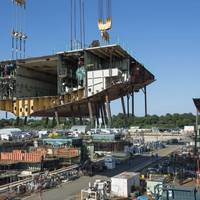
Included in the 2018 National Defense Authorization Act (NDAA) signed today by President Donald Trump is policy to grow the U.S. Navy fleet from its current 279 ships to a minimum of 355. “With his signature, President Trump has confirmed the United States’ resolve to meet the growing needs of our U.S. Navy,” said Senate Seapower Subcommittee Chairman Sen. Roger Wicker (Miss.), who introduced the Securing the Homeland by Increasing our Power on the Seas (SHIPS) Act along with Rep. Rob Wittman (Va.).
Wicker’s SHIPS Act Included in Defense Bill
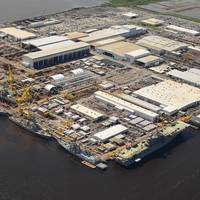
U.S. Senator Roger Wicker, R-Miss., Chairman of the Senate Seapower Subcommittee, announced that he successfully added his “SHIPS Act” proposal to help the Navy reach its requirement of a 355-ship fleet in this year’s “National Defense Authorization Act” (NDAA). The Senate Armed Services Committee unanimously approved the national defense bill, authorizing $640 billion in overall funding for America’s servicemembers, military installations and industrial base. It now awaits consideration by the full Senate.
SeeByte Tapped for UK Navy’s Unmanned Warrior Exercise
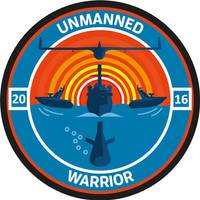
SeeByte, creator of smart software for unmanned maritime systems, said it will demonstrate software solutions for unmanned systems as part of the Royal Navy’s Unmanned Warrior exercise. The exercise will feature more than 50 vehicles, sensors and systems and aims to demonstrate never-seen-before capabilities in the field of autonomy and unmanned systems. SeeByte’s software forms the core components of the Hell Bay 4 and MCM Challenge elements of Unmanned Warrior. The aim of these exercises is to develop and push the capabilities of autonomous systems…
Mine Detection Robot Performs in Bahrain
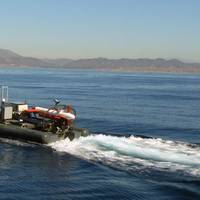
As the demand for naval technology rapidly escalates globally, the Middle East remains a hotspot for investment and innovation. To this end, Northrop Grumman Corporation (NYSE: NOC), in support of U.S. Naval Forces Central Command in Manama, Bahrain, announced the successful demonstration of an unmanned mine-hunting mission. In the demonstration, the Mine Hunting Unmanned Surface Vehicle (MHU) was used in tandem with Northrop Grumman's AQS-24A Mine Detecting Sensor System in the Arabian Gulf.
Royal New Zealand Navy Upgrades Software
SeeByte, the global leader in creating smart software for unmanned maritime systems, is pleased to announce that the Royal New Zealand Navy has chosen to purchase three upgraded seats of SeeTrack Military. The Royal New Zealand Navy, one of SeeByte’s longest-standing customers, first purchased three seats of SeeTrack Military in 2006. The software is now used globally by 16 of the world’s navies. Ron Tyson of New Zealand Offshore Technology (NZOT), who managed the acquisition, commented “It is great news that the Royal New Zealand Navy will have the most up-to-date version of SeeTrack. WOCSS James Harper, Commanding Officer of the Mine Counter Measures Team said: "SeeTrack Military is well known as the MCM software tool of choice.
Unmanned Undersea Minehunter Model Displayed
Representatives from the U. S. Navy's Program Executive Office, Littoral Combat Ships Unmanned Maritime Systems Program Office and General Dynamics unveiled a quarter-scale model of the Surface Mine Countermeasure Unmanned Undersea Vehicle (SMCM UUV), known as "Knifefish," at the Navy League's Sea-Air-Space Exposition being held at the Gaylord National Resort. Knifefish is a heavyweight-class, minehunting, unmanned undersea vehicle designed for deployment by forward operating forces, and will be a part of the Littoral Combat Ship Mine Countermeasures Mission Package. The SMCM UUV system will allow Navy commanders and sailors to detect and identify mines in high-clutter underwater environments without putting sailors in harm's way.
Navy Awards $87m Deal for Mine Countermeasure UUV
The U.S. Navy’s Naval Sea Systems Command has awarded General Dynamics Advanced Informational Systems a contract to design and build the Surface Mine Countermeasure Unmanned Underwater Vehicle (SMCM UUV) system. The system will initially be a part of the Littoral Combat Ship Mine Warfare mission package. The contract has a maximum potential value of $86.7 million for one Engineering Development Model (EDM) and five low-rate initial production systems if all options are exercised. General Dynamics Advanced Informational Systems is a business unit of General Dynamics (NYSE: GD). The SMCM UUV system will allow Navy commanders and sailors to reliably detect and identify mines in high-clutter underwater environments in a single pass…









